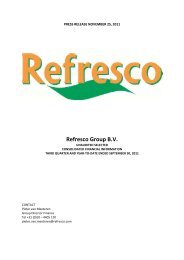You also want an ePaper? Increase the reach of your titles
YUMPU automatically turns print PDFs into web optimized ePapers that Google loves.
Market review 2009<br />
“The premium category offers a huge opportunity<br />
they can build consumer loyalty and are<br />
What differentiations can be ma<strong>de</strong> in private label?<br />
They have enough scale to introduce their private label products<br />
We often make the mistake of talking about private label as one in a wi<strong>de</strong>r range of categories. Second, hard discounters are<br />
single category. The experts distinguish between three types of forcing retailers to have alternatives available for consumers<br />
private label, each having a different starting point, background, looking for value-for-money products. Furthermore, consumer<br />
strategy, and future perspectives. De Jong: “In general we talk awareness has grown through the years; the ‘smart consumer’<br />
about good (value), better (standard), best (premium), the so- was introduced. The recession boosted this trend even further.”<br />
called three-tier structure all carrying the name of the store on Sonneville adds: “An important factor is also: how easily can<br />
the pack. First, we distinguish the type ‘value’: retailers will try you copy a product? And finally, the driving forces behind the<br />
to prevent customers turning to hard discounters<br />
success of private label often coinci<strong>de</strong> with buying<br />
by having their own range of value-formoney<br />
products as an alternative to<br />
hard discount products. Second,<br />
standard: private label can serve<br />
moments and occasions. The recession can<br />
DIFFERENTIATION<br />
function as a stepping stone for private<br />
OF PRIVATE LABEL<br />
label. If the consumer has chosen<br />
Four types can be distinguished:<br />
private label because of its lower<br />
as an alternative to an A-brand:<br />
GOOD<br />
prices during the recession, it is up<br />
a ‘me too’ product. Third, ‘Value’ – an alternative to hard discount products to the food retailer to retain these<br />
premium or niche: more and<br />
more retailers build their own<br />
BETTER<br />
‘Standard’ – ‘me too’ products as an<br />
private label buyers when the<br />
economy recovers. Rather than<br />
retail brand and introduce alternative to traditional mainstream A-brands returning to A-brands, these<br />
products to load their brand<br />
with premium products or to<br />
fill a niche (e.g. organic), often<br />
positioned above A-brands,<br />
BEST<br />
‘Premium’ – loading the retailers<br />
brand via premium or niche products<br />
customers could also opt for<br />
mainstream or premium private<br />
label alternatives.”<br />
transforming the retailer brand<br />
ALTERNATIVE<br />
into an asset.” Grievink: “On top ‘Hard discounter’ – high quality - low<br />
of that, I distinguish a fourth type of<br />
private label in hard discount. This fourth<br />
category of private labels can be found at hard<br />
prices through fancy labels<br />
discounters, who distinguish themselves by a portfolio<br />
of high quality products against low prices presented in fancy<br />
labels. They have no intention to load their own brand via their<br />
products or private labels.”<br />
What explains the success of private label?<br />
Schreijen: “Private label growth is driven by a combination<br />
of three forces: first, retail concentration: the economic<br />
viability of any product launch <strong>de</strong>pends on the size of the<br />
prospective market. Not surprisingly, larger retail chains<br />
generally have been more successful in their private<br />
label strategies.







